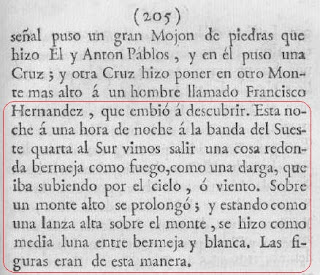Spanish explorer Pedro Sarmiento de Gamboa recorded a strange incident during his voyage of exploration to the Strait of Magellan, it happened on the evening of Sunday, February 7, 1580.
(Sarmiento de Gamboa founded two ill fated colonies on the Strait of Magellan whose inhabitants starved to death, one became known as Port Famine. Only one settler survived to be rescued and taken to Lima).
He recorded the event in his journal and the original text is shown in the following image
Sarmiento de Gamboa's Journal. From [1]
Below is my translation of the original Spanish text. My comments are in brackets “[ ]”:
"Tonight during the evening on the South East side, quarter towards the South [South south east] we saw a round thing, red as fire, like an oval shaped shield, rise; it climbed through the sky, perhaps on the wind. Above a tall mountain it extended [in time or in shape?] , and being as a tall spear upon the mountain, it became like a half moon, tinted between red and white. Its shapes were like these [2] [see fig. 4, in the plates]
The figure drawn in his journal is shown below:
The image of the UFO seen by Sarmiento de Gamboa. From [1]
What could it have been?
What was this U.F.O.? (not in the sense of an alien spacecraft, but as a natural phenomenon). A comet or an eclipse.
Well, there actually was a total moon eclipse with the full moon of Jan 31, 1580, at 21:36 U.T., which would be around 17:36 or 5:36 PM in the area close to Tierra del Fuego (Gamboa was close to the Strait's western mouth) and actually it was visible in that area (see map below).[1]
The Lunar Eclipse of Jan. 31, 1580. By NASA. From [2]
Yes, I know, the dates are wrong, the eclipse happened on January 31st while Sarmiento wrote about something that happened on February 7th!
At first I thought that as Sarmiento’s diary was kept following the dates used back then, in 1579, which corresponded to the Julian calendar introduced by Julius Caesar, the eclipse could account for his sighting.
As you all know, the Julian calendar was out of phase with the real motion of the Earth by about 11 minutes every year. So when Easter began falling behind the “real” astronomical date, Pope Gregory XIII modified the calendar in 1582 to compensate for these 11 minutes per year difference. The Council of Nicea in 325 AD had done a minor adjustment, but by these 11 minutes a day added up to about 10 days in 1582. So in October 1582, the calendar was adjusted and October 15th followed October 4th. Many people wondered what happened to those 10 stolen from their lives!
But this cannot explain the eclipse. Because: 1) Julian Calendar is used to reflect astronomical events prior to 1582 and the NASA website [2] says the eclipse happened on January 31st.
¿Could Sarmiento have mistaken the dates?
By the way, the images seem to show a moon changing shape due to the Earth’s shadow flitting across it. The reddish color is also typical of lunar eclipses.
But we have one week difference!
The answer to my question is NO, he did not mistake the dates, in fact he saw and recorded the lunar eclipse in his journal:
"This Sunday there was a lunar eclipse; and though Sarmiento observed it and it was a clear night, and the Moon appeared in the East while the Sun set, and when it rose, it appeared round and totally un-eclipsed, but its redness and darkness that came over the sky as it showed itself above the Eastern horizon...." [1] pp. 184
So we can forget about the eclipse! I could not find any comets during that period either.
Perhaps some distant volcano’s eruption reflecting on a cloud blown by Patagonia’s wind?
A mystery, but I don’t think it can be due to an extraterrestrial alien craft.
Then again, the image in Sarmiento de Gamboa's journal looks like the Moon during Last Quarter, and, on February 8th that was precisely the Moon's phase. Could a volcanic eruption have caused the Moon to appear red? This is quite a common phenomenon, "blood red" Moon due to volcanic ash in the air (I have seen it due to Puyehue Volcano's recent eruption).
Sources
[1] Sarmiento de Gamboa, P., (1768). Viaje al Estrecho de Magallanes por el Capitán Pedro Sarmiento de Gamboa en los años de 1579 y 1580… Madrid: Imprenta Real de la Gazeta. Pp 205 and plates.
[2] NASA. Phases of the Moon: 1501 to 1600
Patagonian Monsters - Cryptozoology, Myths & legends in Patagonia2011 International Year of Forests Copyright 2009-2011 by Austin Whittall ©




















No comments:
Post a Comment